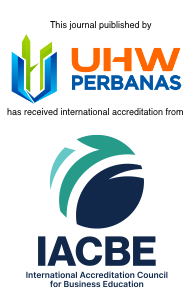Sticky cost determinants: Which one has the stronger impact?
DOI:
https://doi.org/10.14414/tiar.v12i2.2825Keywords:
Sticky Cost, Covid-19, Tangible and Itangible Resources, Management Incentives, ProfitabilityAbstract
Sticky cost is a phenomenon that can occur in companies and it is an unbalanced response of costs to changes in output. Since it can reduse company profits, it should not occur. Therefore, it is important to know the determinants that influence it so that the company can control properly redusing it. The aim of this research is to test which the determinants that have the impact of Covid-19, asset intensity, employee intensity, equity intensity, management incentives, profitability, and intellectual capital on sticky cost.This research is a quantitative research with  object of manufacturing companies listed on the Indonesia Stock Exchange with observation period of 2019-2020. This research uses financial data from annual report and summary of minutes General Meeting of Shareholders. The sample selection technique used purposive sampling method. This research involved two data analysis techniques. There are multiple linear regression for main test and logistic regression for additional test. The results of the main test show that employee intensity and intellectual capital have impact on sticky cost. But, the Covid-19, asset intensity, equity intensity, management incentives, and profitability have no impact on sticky cost. The main test result is supported by the additional test, in term of first, intellectual capital has impact on sticky cost. Second, the other determinants remain no impact on sticky cost. The implications of this research are management should be carefull to make investment in intangible assets and use employee intensive. As those determinants can increase sticky cost.
References
Afiffah, A., Murdayanti, Y., & Purwohedi, U. (2018). Fenomena Perilaku Sticky Cost pada Perusahaan Manufaktur di Indonesia. Jurnal Akuntansi, 18(1), 141–152.
Alenezi, M. M. (2020). The Influence of the Trade-off Between Profitability and Future Increases in Sales and Cost Stickiness: Evidence form Jordan. Modern Applied Science, 14(5), 19–28.
Anriva, D. H., Azmi, Z., Binangkit, I. D., & Ramashar, W. (2019). The Effect of Intellectual Capital and Company Size on Sticky Cost: Empirical Study of Manufacturing Companies in Indonesia Stock Exchange. Jurnal Akuntansi Dan Ekonomika, 9(2), 233–242.
Aprillya, L. W. (2017). Pengaruh Free Cash Flow dan Agency Cost Terhadap Kinerja Perusahaan Manufaktur Yang Terdaftar di Bursa Efek Indonesia.
Astuti, S. D. (2020). Sinar Matahari, Sterilisator, dan Penguat Imun. Jawa Pos, 4.
Azmi, Z., & Januryanti. (2021). Faktor-Faktor yang Mempengaruhi Sticky Cost. Jurnal Manajemen Dan Sains, 6(1), 274–280.
David, F. R., & David, F. R. (2016). Manajemen Strategik: Suatu Pendekatan Keunggulan Bersaing.
Dini, E. (2020). Timeline Penularan Covid-19 Pada Dua WNI Asal Depok. Jawa Pos, 1.
Edvinsson, L., Matos, F., Selig, P. M., & Vairinhos, V. (2019). Intellectual Capital Management as a Driver of Sustainability.
Eltivia, N., Martania, R. M., & Setiawan, M. A. (2018). Apakah Earnings Management Mampu Mengurangi Tingkat Stickiness Cost. Jurnal Reviu Akuntansi Dan Keuangan, 8(2), 125–134.
Evelyn. (2018). Pengaruh Perubahan Penjualan, Asset Intensity, Profitability, Size, dan Leverage terhadap Cost Stickiness. Jurnal Muara Ilmu Ekonomi Dan Bisnis, 2(2), 416–423.
Fanani, Z., & Tiono, I. (2017). Dampak Keputusan Manajer Terhadap Biaya Sticky. Jurnal Investasi Islam, 2(2), 45–58.
Hansen, D. R., & Mowen, M. (2016). Akuntansi Manajerial.
Hitt, M. A., Ireland, R. D., & Hoskisson, R. E. (2017). Strategic Management Competitiveness & Globalization Concepts and Cases.
Hughes, R. J., Kapoor, J. R., & Pride, W. M. (2017). Pengantar Bisnis.
Jazuli, M. A., Maksum, A., & Rini, E. S. (2020). Analisis Faktor-Faktor Yang Mempengaruhi Cost Stickiness Pada Perusahaan Manufaktur Yang Terdaftar Di Bursa Efek Indonesia Periode 2014-2018. Jurnal Sains Sosio Huaniora, 4(1), 205–222.
Jo, E. H., Kwak, J. Y., & Lee, J. W. (2021). Impact of COVID-19 on R&D Cost Stickiness in IT industry. International Journal of Internet, Broadcasting and Communication, 13(2), 36–42.
Kama, I., & Weiss, D. (2013). Do Earning Targets and Managerial Incentives Affect Sticky Cost? Journal of Accounting Research, 15(1), 201–224.
Kieso, D. E., Warfield, T. D., & Weygandt, J. J. (2018). Intermediate Accounting: IFRS edition.
Linggardjaja, I. K. (2020). Faktor-Faktor Yang Mempengaruhi Cost Stickiness: Suatu Kajian Pustaka. Jurnal Ilmiah Manajemen, Ekonomi, Dan Akuntansi, 4(1), 52–65.
Mohammadi, A. Z., & Taherkhani, P. (2017). Organizational Capital, Intellectual Capital and Cost Stickiness: Evidence from Iran. Journal of Intellectual Capital, 18(3), 625–642.
Nuridah, S. (2019). Analisis Perilaku dan Faktor-Faktor yang Mempengaruhi Cost Stickiness pada Perusahaan Manufaktur yang Terdaftar di Bursa Efek Indonesia Periode Tahun 2014-2018.
Rosini, L. (2021). Sistem Pengendalian Manajemen Berorientasi Keberlanjutan.
Santoto, V. H., & Rachmawati, D. (2021). Pengaruh Ukuran Perusahaan, Remunerasi CEO Dan Modal Intelektual Terhadap Sticky Cost Pada Perusahaan Manufaktur Yang Terdaftar BEI Tahun 2018-2019. Jurnal Akuntansi Dan Pajak, 22(1), 1–8.
Soenjoto, E. A., & Alfiandri. (2019). The Asymmetrical Cost Behavior: Cost Stickiness in Indonesian Listed Manufacturing Companies. International Journal of Accounting and Taxation, 7(1), 26–34.
Solomon, J. (2020). Corporate Governance and Accountability.
Szelagowski, M. (2019). Dynamic Business Process Management in the Knowledge Economy: Creating Value from Intellectual Capital.
Yang, Y. (2018). Do Accruals Earnings Management Constraints and Intellectual Capital Efficiency Trigger Asymmetric Cost Behaviour? (Evidence from Australia). Australian Accounting Review, 29(1), 177–192.
Downloads
Additional Files
Submitted
Published
How to Cite
Issue
Section
License
Copyright (c) 2022 The Indonesian Accounting Review

This work is licensed under a Creative Commons Attribution-NonCommercial 4.0 International License.


















